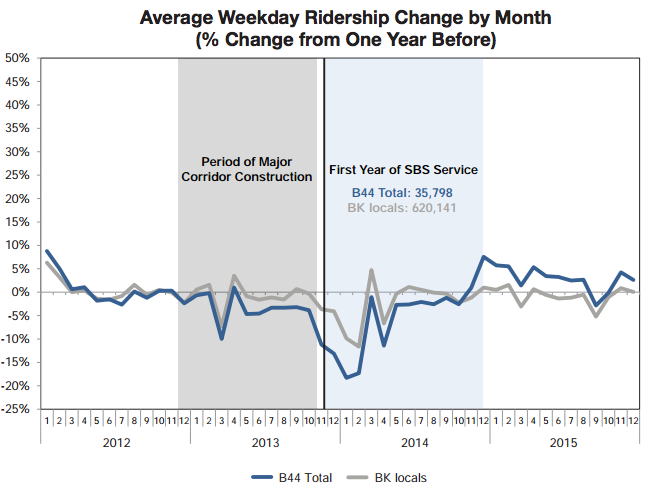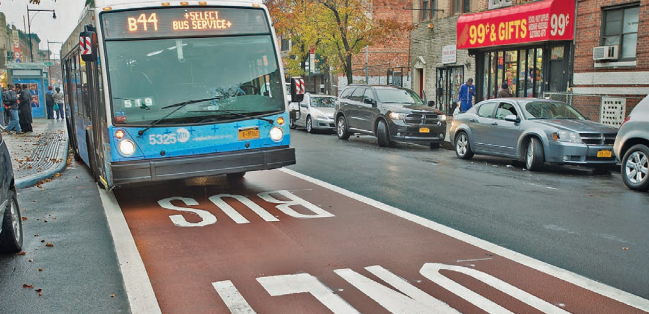
As bus speeds decline in NYC, the few routes that are getting dedicated bus lanes and off-board fare collection are bucking the trend. The newest evidence comes from the B44 route along Nostrand Avenue and Rogers Avenue in Brooklyn, where buses are moving 15-30 percent faster since NYC DOT and the MTA upgraded the line to Select Bus Service, according to an update the agencies released yesterday [PDF]. Ridership on the route increased in 2015, going against the borough-wide pattern, following years of ridership losses before and during SBS implementation.
SBS upgrades make routes faster and more reliable via camera-enforced bus lanes, off-board fare collection, bus bulbs that expand waiting areas and enable bus drivers to make stops without pulling in and out of traffic, stop consolidation, and traffic signals that prioritize buses. On the B44, which runs between Sheepshead Bay and Williamsburg, total northbound travel times improved 31 percent during the morning peak and 20 percent in the evening after SBS launched. Southbound travel times improved by 19 percent in the morning and 15 percent in the evening.
The SBS improvements reduced the amount of time B44 buses spend motionless at stops, traffic lights, and stuck behind general traffic. While total time in motion before and after SBS remained relatively steady on the B44, it now accounts for 57 percent of travel time, compared to 45 percent before implementation.
The most substantial reductions in travel time occurred where dedicated bus lanes were installed, primarily north of the intersection of Nostrand and Flatbush Avenue. Between Flatbush and Fulton Street, where most of the bus lanes were installed, northbound travel times improved by 37 percent in the morning and 33 percent in the evening. (The lack of bus lanes on the southern part of the route shows: The agencies note that overall B44 speeds are lower than on other bus lines where DOT installed dedicated lanes along the entire route.)
Ridership on the B44 was trending downward before implementation of SBS and continued to drop during construction of the project in 2013 and the months immediately following launch, which the report attributes to "major corridor construction and the resulting slowdowns, customers adjusting to the new service, and the unusually bad winter in late 2013, early 2014." (One major adjustment was shifting B44 Limited service on New York Avenue two blocks west to Rogers Avenue, which shaved about half a mile off the total route distance.)
Since the fall of 2014, B44 ridership trends have been more positive than borough-wide trends. In 2015, B44 ridership began to rebound, increasing 2.7 percent on the whole corridor (including SBS and local service) compared to a ridership drop of 0.8 percent on all non-express Brooklyn buses.


The faster bus speeds and recent gains in ridership on the B44 show that SBS improvements can reverse the citywide deterioration of bus service described in DOT's recent "Mobility Report," which found that average bus speeds have fallen two percent and ridership has declined 7 percent since 2010.
One promising way to take SBS-style improvements citywide would be for the MTA's next-generation fare system to enable electronic proof-of-payment on all buses, speeding up the boarding process like SBS routes do. So far, however, the MTA has not committed to electronic proof of payment as it seeks a contractor for the new fare system.






